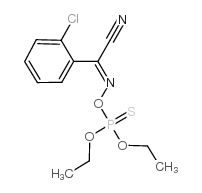Resistance to organophosphate and carbamate insecticides in Anopheles atroparvus.
J Hemingway, G Davidson
文献索引:Parassitologia 25(1) , 1-8, (1983)
全文:HTML全文
摘要
Adult Anopheles atroparvus, from Cadiz, Spain (strain AT SPA) were resistant to several organophosphorus and carbamate insecticides. Separate lines of the AT SPA strain selected with propoxur, fenitrothion, fenthion and malathion were cross-resistant to these insecticides as well as chlorphoxim and bendiocarb. Lack of synergism between malathion and triphenyl phosphate (TPP), a carboxylesterase inhibitor and between fenitrothion and piperonyl butoxide (PB), a multi-function oxidase inhibitor, against the selected lines suggests that resistance to these insecticides may be non-metabolic. Lack of synergism of propoxur after 2 h exposure with PB, sensamex and SV1 (which all inhibit multi-function oxidases), may suggest that the same mechanism is involved here. However, all three synergists were effective in conjunction with 6 h exposure to propoxur. The postulated mechanisms are: a non-metabolic resistance, possibly an altered site of action, responsible for the non-synergizable resistance to organophosphorus insecticides and to a lesser extent the carbamates and a multi-function oxidase inhibitor-suppressed mechanism conferring resistance to propoxur.
相关化合物
| 结构式 | 名称/CAS号 | 分子式 | 全部文献 |
|---|---|---|---|
 |
氯辛硫磷
CAS:14816-20-7 |
C12H14ClN2O3PS |
|
Evaluation of chlorphoxim used against Anopheles albimanus o...
1984-01-01 [Bull. Pan Am. Health Organ. 18(4) , 379-88, (1984)] |
|
[Effect of temephos on acetylcholinesterase activity in the ...
1983-03-01 [Toxicol. Eur. Res. 5(2) , 63-9, (1983)] |
|
Evaluation of chlorphoxim used against Anopheles albimanus o...
1985-01-01 [Bull. Pan Am. Health Organ. 19(1) , 61-8, (1985)] |
|
Chemical control on malaria vector Anopheles aconitus in Cen...
1985-03-01 [Southeast Asian J. Trop. Med. Public Health 16(1) , 153-62, (1985)] |
|
Relative toxicity of decamethrin, chlorphoxim and temephos (...
1981-09-01 [Tropenmed. Parasitol. 32(3) , 189-93, (1981)] |